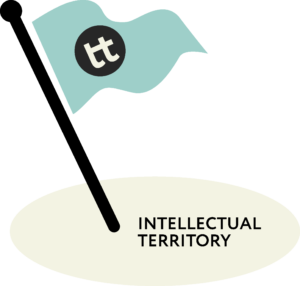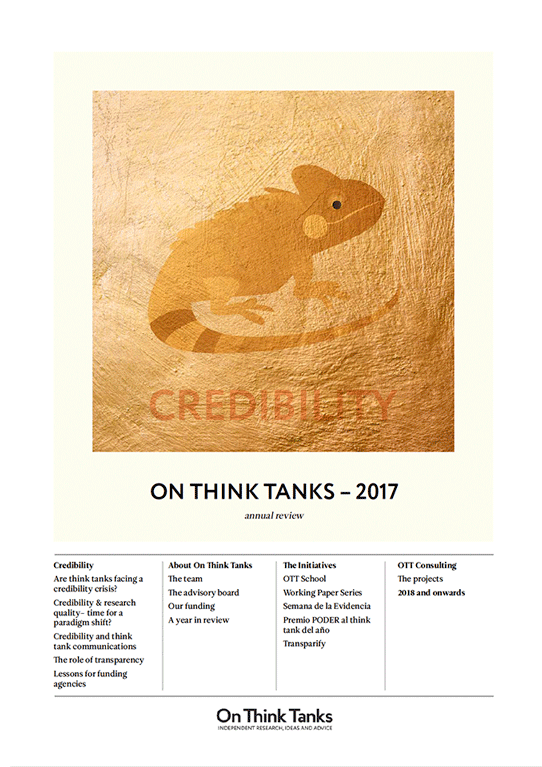During the OTT Conference this past February, John Schwartz from Soapbox talked about branding and how a brand should help a think tank stake out their piece of cultural and intellectual territory. He wrote about it as well in an article where he shares the rebranding process for the Stockholm Environment Institute (SEI).
A few weeks ago I had a conversation with the co-founder of MA’AM, a New York based creative studio. Although their experience is far from the world of think tanks and knowledge production, their branding expertise is relevant to any sector. She argues that today’s ‘new’ brands want (or should want) their processes to be scrappy, flexible, agile and nimble. Two of these words immediately spoke to me about OTT: scrappy and flexible.
All this has coincided with conversations we have had over the past few months about the OTT brand and what it represents.
OTT is not a think tank per se, but we do work generating knowledge for think tanks. We are also not a start-up and, although we are a young brand, we are not ‘new’ anymore (we turn eight this year!). Our brand falls somewhere between staking out its own piece of intellectual territory and responding to today’s buzz words.
On being scrappy
Being scrappy, in the sense of what a modern brand represents, refers to being able to do more with less.
As an OTT insider, I am privy to how we make the most of the resources we have at hand. + Of course we rely on an amazing network of supporters and contributors, but we also invest in the things that matter (and hold back on those that we feel we can hold off on). And we take these investments to the next level. Our annual conference is a perfect example of this. We maximise the impact of this event, both internally and externally. During the first two days of the conference the OTT team meets to work on long-term projects (or propose new ones). During the open conference we generate new content and resources for our readers. The key thing here is that we don’t wait for this to happen, we plan for it. Post-conference work is almost as intense as pre-conference work for us- this one event leads to more than twenty resources in the first three months after it.
As far as the OTT team goes, we all wear different hats. This past December, for instance, Andrea Baertl, along with Jeff Knezovich, was gathering and revising endless amounts of data for the Open Think Tank Directory, while also working closely with the authors of the third publication of the Working Paper Series, writing her own working paper, and preparing four presentations for the OTT Conference. Jeff, at the same time, was working on the Directory, wrapping up the 2017 comms long course and preparing the 2018 version along with Carolina Kern, while also working on a dashboard for IFAD’s new M&E system. Leandro Echt meanwhile was producing the end of the year reports for the OTT School, preparing for the WinterSchool in Geneva in February 2018, finishing a two-year long project on think tanks and elections for ILAIPP and writing up the final reports with Stephen Yeo on their work with the Asia Foundation on setting up a think tank in Timor Leste. I could go on, but I think the point I am trying to make is that we maximise our skillset to make sure we are doing the most we can with the resources we have.
On being flexible
The nature of our work and our set-up demands that we are flexible: we have to be responsive to our environment, funding and context/s. Last year, for instance, we were set up to work with quite a bit of external support, whereas this year we have been able to rearrange our structure to produce most of our outputs in-house.
As for the content we produce, Enrique’s advice has often been to not aim for perfect, but rather for good enough. By no means is he advising us to produce work that is subpar, but rather that it be fit for purpose: he sees our content as conversation openers (or as part of the conversation). If our articles are not presented as the final word, people will be more likely to comment, suggest improvements, provide insight or openly disagree. This means we leave the door open for improvements considering insights from our audience.
In terms of our sustainability, we established our consulting branch and continue to seek new sources of funding. When we set up OTT Consulting, we knew we had to be prepared to meet the demand- and we didn’t know what the volume of this demand would be. As it turned out, in a given span of two months, we were juggling up to six consulting projects, on top of our OTT activities. We were prepared to crank up the pressure, work long hours to deliver, and be flexible.
How does our brand represent all of this?
The OTT Annual Review is perhaps the best example of how OTT has evolved as a brand- and how we are prepared to stake out our own piece of intellectual territory. The process is a great example of how we are both scrappy and flexible.
We knew from the onset that we wanted to produce a piece of work that spoke not so much about OTT and our accomplishments, but about what these mean. Yes, we wanted to include our numbers, but we wanted to reflect on these. We also knew we wanted to produce something that responded to the current challenges think tanks are facing, where we could include a plurality of voices.
What we also knew was that by asking over 30 authors to contribute to our report it would be hard to foresee what the outcome would look like.
What we did have control over, however, was the process. We worked on the outline of the report and identified potential authors for each of the sections and individual pieces. We sketched out some concepts for each of them, and approached them a couple of months before the deadline. We made sure to be available for advice and revisions along the way, before their articles were sent off for final editing before inserting in the layout.
Although we never thought of it as a typical annual report, we planned for one for over four months. We never called it anything but an annual report, until the day after we launched it. Why the change? We knew the moment we finalised the 140-page compilation of voices, opinions and experiences that it was much more than an annual report (or much less, depending on what you would expect to find). After the soft launch during the OTT team meeting we discussed changing report for review, but couldn’t agree on if this was the right move. Two days later, during a presentation on the future of think tank communications at the OTT Conference, Ruth Levine from the Hewlett Foundation asked the panel if they thought organisations should produce annual reports. The panel was quick to respond: no. What did she think? She concurred by giving a thumbs down.
If ever there was a moment that could break our confidence in investing to produce these long publications, it was this one. Yet somehow it didn’t. We knew we had produced a valuable piece of work, but we had erred in naming it. Upon hearing the exchange on the yaye or naye for annual reports, we finally decided that swapping report for review was, indeed, the right move.
Our Annual Review was designed as a product which can be broken down into smaller, bite-size pieces. Some of the articles have been published on OTT, it has provided content for social media, conversation starters during meetings and our internal analysis has served for reporting purposes. This in turn has encouraged others to join the conversation. If it was a perfectly finalised piece, we would be hesitant to unassembled it.
Whose territory?
OTT’s brand continues to grow. We continue to work to ensure each of our outputs represent our mission and how we want to communicate with our audiences. As far as staking out our own intellectual territory goes, we continue to create resources to promote the role of think tanks and evidence informed policymaking.

It is not so much about where we hope to pin our flag, but rather about being part of every conversation on the role of think tanks in developing countries and emerging economies. And we want to continue to provide the resources policy entrepreneurs need to develop a healthy think tank ecosystem.
The Annual Review, and OTT more broadly, is an invitation: we want to host you and your ideas about evidence informed policy and think tanks. We do not expect to come up with the best ideas all the time, but we hope to be host to them.
Looking ahead, the challenge our initiative and our brand face is finding the best possible ways to work in partnership with others. To learn together, to develop new ways to understand the role of evidence in policy together, to design new interventions together. This will, no doubt, require a scrappy, flexible, agile and nimble approach.


